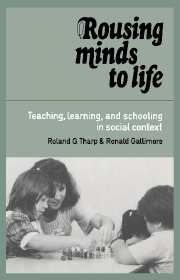Book contents
- Frontmatter
- Contents
- Acknowledgments
- Introduction
- Part I Teaching, schooling, and literacy: a unified theory of education
- 1 The redefinition of teaching and schooling
- 2 A theory of teaching as assisted performance
- 3 The means of assisting performance
- 4 The social organization of assisted performance
- 5 Language, literacy, and thought
- Part II Practice
- References
- Author index
- Subject index
1 - The redefinition of teaching and schooling
Published online by Cambridge University Press: 05 June 2012
- Frontmatter
- Contents
- Acknowledgments
- Introduction
- Part I Teaching, schooling, and literacy: a unified theory of education
- 1 The redefinition of teaching and schooling
- 2 A theory of teaching as assisted performance
- 3 The means of assisting performance
- 4 The social organization of assisted performance
- 5 Language, literacy, and thought
- Part II Practice
- References
- Author index
- Subject index
Summary
Go back in memory. To the school of your childhood. Go further, if you can – travel back in time, to the North American classrooms of your great great grandmothers. Go back a century. The trick would be to keep your eyes closed. Of course there are fewer jeans, and the skirts are different. Textbooks are less brightly colored. But blindfolded, you might not notice the time warp. Listening to the teachers, you would hear speech almost indistinguishable from the way teachers are talking to your son and daughter today.
Before the Civil War
Young teachers are very apt to confound rapid questioning and answers with sure and effective teaching.
(Morrison, 1860, p. 303; quoted in Hoetker & Ahlbrand, 1969, p. 153)At the turn of the century
Sara Burstall, an Englishwoman, visited American schools in 1908 and was struck by the ubiquity of the “time-honoured” question-answer recitation.… In the European schools the teacher was at the center of the learning process; he lectured, questioned the pupils, and “buil[t] up new knowledge in class.” In contrast, in the American classroom, “clearly … the master is the textbook.” The teacher does not really teach but “acts rather as chairman of a meeting, the object of which is to ascertain whether [or not the students] have studied for themselves in a textbook.
(Burstall, 1909, pp. 156–158; quoted in Hoetker & Ahlbrand, 1969, p. 150)- Type
- Chapter
- Information
- Rousing Minds to LifeTeaching, Learning, and Schooling in Social Context, pp. 13 - 26Publisher: Cambridge University PressPrint publication year: 1989



